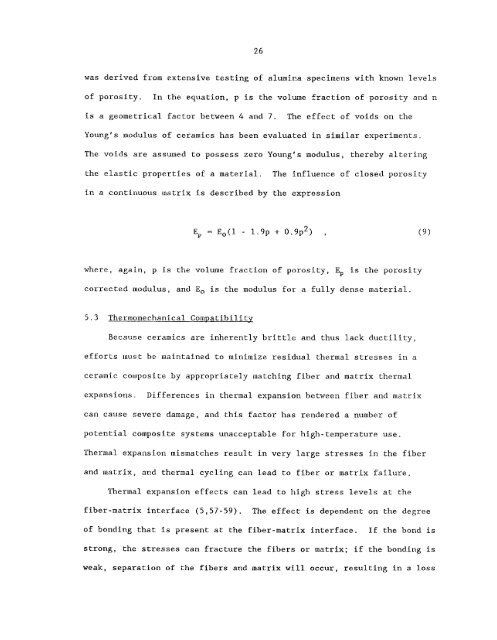Characterization and control of the fiber-matrix interface in ceramic ...
Characterization and control of the fiber-matrix interface in ceramic ...
Characterization and control of the fiber-matrix interface in ceramic ...
You also want an ePaper? Increase the reach of your titles
YUMPU automatically turns print PDFs into web optimized ePapers that Google loves.
26<br />
was derived from extensive test<strong>in</strong>g <strong>of</strong> alum<strong>in</strong>a specimens with known levels<br />
<strong>of</strong> porosity.<br />
In <strong>the</strong> equation, p is <strong>the</strong> volume fraction <strong>of</strong> porosity <strong>and</strong> n<br />
is a geometrical factor between 4 <strong>and</strong> 7.<br />
The effect <strong>of</strong> voids on <strong>the</strong><br />
Young's modulus <strong>of</strong> <strong>ceramic</strong>s has been evaluated <strong>in</strong> similar experiments.<br />
The voids are assumed to possess zero Young's modulus, <strong>the</strong>reby alter<strong>in</strong>g<br />
<strong>the</strong> elastic properties <strong>of</strong> a material.<br />
The <strong>in</strong>fluence <strong>of</strong> closed porosity<br />
<strong>in</strong> a cont<strong>in</strong>uous r<strong>in</strong>atrix is described by <strong>the</strong> expression<br />
E, = Eo(l - 1.9p + 0.9p 2 ) ,<br />
(9)<br />
where, aga<strong>in</strong>, p is <strong>the</strong> volume fraction <strong>of</strong> porosity,<br />
E,<br />
is <strong>the</strong> porosity<br />
corrected modulus, <strong>and</strong> Eo is <strong>the</strong> modulus for a fully dense material.<br />
5.3 Lhg.rmomechanica1 Compatibility<br />
Because <strong>ceramic</strong>s are <strong>in</strong>herently brittle <strong>and</strong> thus lack ductility,<br />
efforts iiiust be ma<strong>in</strong>ta<strong>in</strong>ed to m<strong>in</strong>imize residual <strong>the</strong>rmal stresses <strong>in</strong> a<br />
<strong>ceramic</strong> composite by appropriately match<strong>in</strong>g <strong>fiber</strong> <strong>and</strong> <strong>matrix</strong> <strong>the</strong>rmal<br />
expansions.<br />
Differences irn <strong>the</strong>rmal expansion between <strong>fiber</strong> <strong>and</strong> <strong>matrix</strong><br />
can cause severe damage, <strong>and</strong> this factor has rendered a nu<strong>in</strong>bc1r <strong>of</strong><br />
potential composite systems unacceptable for high-temperature use.<br />
Thermal expansion mismatches result <strong>in</strong> very large stresses <strong>in</strong> <strong>the</strong> <strong>fiber</strong><br />
<strong>and</strong> <strong>matrix</strong>, <strong>and</strong> <strong>the</strong>rmal cycl<strong>in</strong>g can lead to <strong>fiber</strong> or <strong>matrix</strong> failure.<br />
Thermal expansion eEfects can lead to liigh stress levels at <strong>the</strong><br />
<strong>fiber</strong>-<strong>matrix</strong> <strong><strong>in</strong>terface</strong> (5,57-59).<br />
The effect is dependent on <strong>the</strong> degree<br />
<strong>of</strong> bornd<strong>in</strong>g that is present at <strong>the</strong> <strong>fiber</strong>-<strong>matrix</strong> <strong><strong>in</strong>terface</strong>.<br />
If <strong>the</strong> bond is<br />
strong, <strong>the</strong> stresses can fracture <strong>the</strong> <strong>fiber</strong>s or <strong>matrix</strong>; if <strong>the</strong> bond<strong>in</strong>g is<br />
weak, separation <strong>of</strong> <strong>the</strong> <strong>fiber</strong>s <strong>and</strong> <strong>matrix</strong> will occur, result<strong>in</strong>g <strong>in</strong> a loss

















